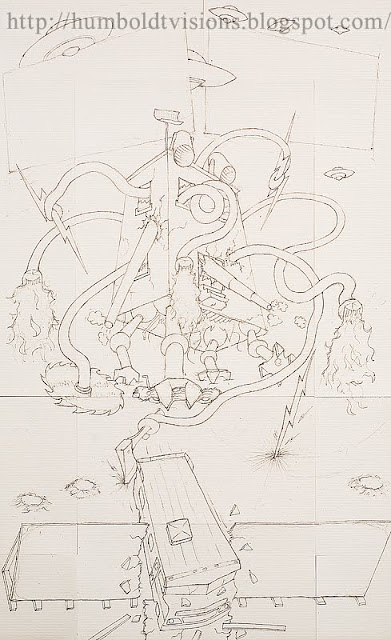Trying to find something to use as a cover image for a Ken Scholes’ book is like going fishing with really good bait, or uhm, hunting for ducks at the height of duck season with a really good gun presuming you are a good shot and in this case imagine that you are (even though I’m not a hunter per se, unless my glasses or car keys are involved somehow), or going to bake a cake and you have only the finest ingredients and the most modern kitchen and you have had years of training in the finest French pastry school, even won several awards, Julia Child probably invited you to do a cooking show with her…I forgot what I was getting at here?
Anyway Ken’s latest, soon to be published, book, Diving Mimes, Weeping Czars and Other Unusual Suspects is a rich and inventive collection of highly imaginative tales. (Get ready for a billiards metaphor) Ken literally runs the table of ideas from an inter-dimensional love story to a Fellini-esque account of the apocalypse. And it is the latter story, Grail-Diving in Shangrilla with the World’s Last Mime that sunk the 8 ball, er, so to speak, and gave me the rich material I needed to create the cover for his book.
In the story a rag-tag group of protagonists are battling an invading evil alien armada, made up of hobgoblins and large building-like structures with flailing arms that deal out mayhem in the form of fire, bolts of lightning and blades, really sharp blades. Did I mention the canons?
When envisioning the image, I was thinking of something along the lines of Hieronymus Bosch meets Mad Magazine.
So, just to take you on a little trip through the ole creative process, below is one of several rough sketches done on the back of some scratch paper. I know it’s a little difficult to tell what’s going on here, but central we’ve got the killer building itself chasing down the fleeing Winnebago, which is busting through a billboard emblazoned with the author’s name. It should be noted that the billboard is not in the story, nor are the signs above suspended from the flying saucers, but I wanted to incorporate the titles into the image.
Below is the final drawing done for the cover on watercolor paper. If it looks like it was done on several sheets of paper taped together, that’s because it was, for no real good reason (this is warts and all here folks).
From here, I wasn’t a 100% sure how I was going to proceed. Ultimately what I decided I wanted was a collage-like feel, something that would enhance the crazy nature of the image, so I used the drawing as a template and began placing and layering bits and pieces of stuff to create the image, photoshopping in shadows, transforming shapes to fit. In all, there are over 170 layers (different parts) that comprised the final image, (not that I’m bragging or anything). It was a blast to create and when I was finished I looked at it, feeling most pleased, and said “cool”.


























